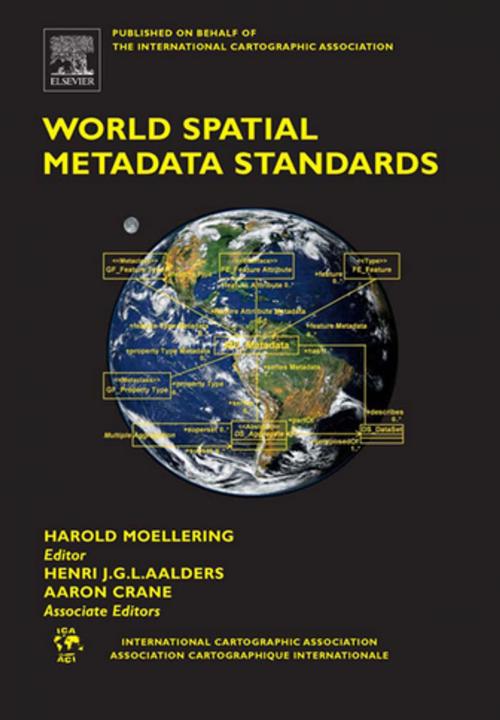World Spatial Metadata Standards
Scientific and Technical Characteristics, and Full Descriptions with Crosstable
Nonfiction, Science & Nature, Technology, Remote Sensing, Science, Earth Sciences| Author: | ISBN: | 9780080457611 | |
| Publisher: | Elsevier Science | Publication: | November 8, 2005 |
| Imprint: | Pergamon | Language: | English |
| Author: | |
| ISBN: | 9780080457611 |
| Publisher: | Elsevier Science |
| Publication: | November 8, 2005 |
| Imprint: | Pergamon |
| Language: | English |
World Spatial Metadata Standards represents years of work by the ICA Spatial Data Standards Commission during the 1995-2003 ICA cycles.
It consists of an Introduction and six Regional Summary chapters that describe the spatial metadata activities happening in Europe, North America, Asia/Pacific, Latin America, Africa/Middle East, and the ISO community. These chapters provide the broader context and description of the milieu in which these standards operate, so that the reader can more easily understand the scientific and technical framework from whence a particular standard has emerged. The third section is a complete listing of all of the three levels of scientific and technical characteristics, and their meaning by the inclusion of a set of definitions for metadata terms used in the book. The fourth section, and by far the largest, contains 22 chapters that assess each of the major national and international spatial metadata standards in the world, and also contains a few representative subject matter profile derived from a major standard. They have been carried out in terms of all three levels of characteristics. Each assessment has been carried out by a Commission member who has been an active participant in the development of the standard being assessed in the native language of that standard. The fifth section contains a summary cross-table wall size summary chart that includes all 22 standards and profiles that are cross tabulated by 70 of the crucial characteristics. The columns provide a thumbnail sketch of each individual standard, while the rows facilitate a quick comparison of individual critical characteristics across all of the 22 standards and profiles. Many readers of our previous book have begun their standards evaluation process with this cross-table.
This current book on spatial metadata standards has been purposely designed to serve as a companion working volume to the 1997 book the Commission published on Spatial Data Transfer Standards, Moellering & Hogan, Editors, ISBN 008042433.
- Assesses the National and International Spatial Metadata Standards & Profiles in their native languages, and then reports the analysis in a scientifically consistent manner in a widely used scientific language (English)
- Provides a summary Crosstable of the 22 Spatial Metadata Standards/Profiles in a large wall-sized table highlighting 70 of the most important scientific characteristics
- Provides the scientific and technical detail for each of the 22 Standards/Profiles to 12 primary levels, 58 second levels, and about 278 tertiary levels. Scientific and technical characteristics can be used for a wide variety of uses with spatial metadata and associated standards
World Spatial Metadata Standards represents years of work by the ICA Spatial Data Standards Commission during the 1995-2003 ICA cycles.
It consists of an Introduction and six Regional Summary chapters that describe the spatial metadata activities happening in Europe, North America, Asia/Pacific, Latin America, Africa/Middle East, and the ISO community. These chapters provide the broader context and description of the milieu in which these standards operate, so that the reader can more easily understand the scientific and technical framework from whence a particular standard has emerged. The third section is a complete listing of all of the three levels of scientific and technical characteristics, and their meaning by the inclusion of a set of definitions for metadata terms used in the book. The fourth section, and by far the largest, contains 22 chapters that assess each of the major national and international spatial metadata standards in the world, and also contains a few representative subject matter profile derived from a major standard. They have been carried out in terms of all three levels of characteristics. Each assessment has been carried out by a Commission member who has been an active participant in the development of the standard being assessed in the native language of that standard. The fifth section contains a summary cross-table wall size summary chart that includes all 22 standards and profiles that are cross tabulated by 70 of the crucial characteristics. The columns provide a thumbnail sketch of each individual standard, while the rows facilitate a quick comparison of individual critical characteristics across all of the 22 standards and profiles. Many readers of our previous book have begun their standards evaluation process with this cross-table.
This current book on spatial metadata standards has been purposely designed to serve as a companion working volume to the 1997 book the Commission published on Spatial Data Transfer Standards, Moellering & Hogan, Editors, ISBN 008042433.
- Assesses the National and International Spatial Metadata Standards & Profiles in their native languages, and then reports the analysis in a scientifically consistent manner in a widely used scientific language (English)
- Provides a summary Crosstable of the 22 Spatial Metadata Standards/Profiles in a large wall-sized table highlighting 70 of the most important scientific characteristics
- Provides the scientific and technical detail for each of the 22 Standards/Profiles to 12 primary levels, 58 second levels, and about 278 tertiary levels. Scientific and technical characteristics can be used for a wide variety of uses with spatial metadata and associated standards















